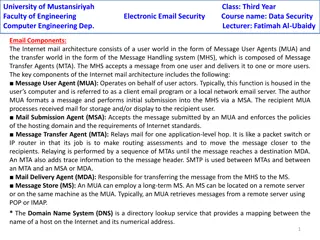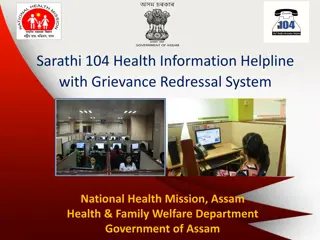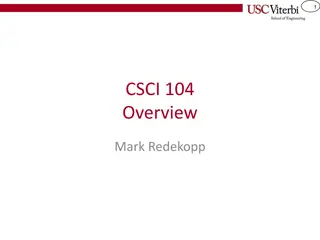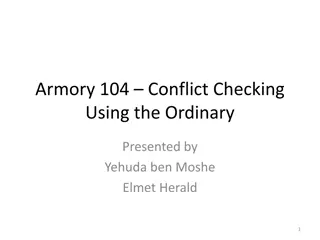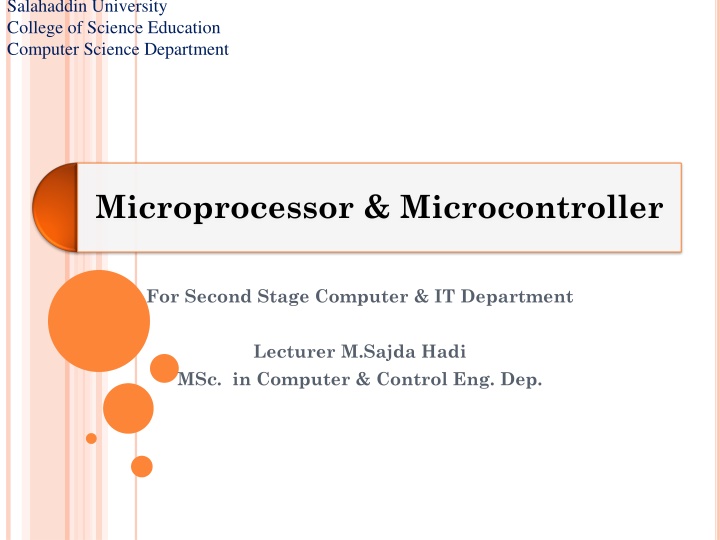
Microprocessor and Microcontroller Course Overview at Salahaddin University
Explore the detailed course structure focusing on 8086 Microprocessor architecture, assembly language, addressing modes, and practical training on EMU8086. Learn about CPU components, memory operations, I/O controllers, and various microcontroller types. Delve into stack concepts, instruction sets, interrupts, and different CPU architectures like RISC and CISC. Discover how to work with microcontrollers, select memory, and utilize communication peripherals.
Download Presentation

Please find below an Image/Link to download the presentation.
The content on the website is provided AS IS for your information and personal use only. It may not be sold, licensed, or shared on other websites without obtaining consent from the author. If you encounter any issues during the download, it is possible that the publisher has removed the file from their server.
You are allowed to download the files provided on this website for personal or commercial use, subject to the condition that they are used lawfully. All files are the property of their respective owners.
The content on the website is provided AS IS for your information and personal use only. It may not be sold, licensed, or shared on other websites without obtaining consent from the author.
E N D
Presentation Transcript
Salahaddin University College of Science Education Computer Science Department Microprocessor & Microcontroller For Second Stage Computer & IT Department Lecturer M.Sajda Hadi MSc. in Computer & Control Eng. Dep.
REFERENCES The 8086 Microprocessors Architecture,software and Interfacing techniques, By: Walter A. Triebel The 8086/8088 MPU, Architecture,programming and interfacing, BY: Barry B. Brey Introduction to Microcontrollers, ,G unther Gridling, Bettina Weiss, February 26, 2007 Microcontroller and Embedded Systems Laboratory, Authors: Kileen Cheng, Patrick Frantz, CJ Ganier, October 25, 2012 Singh ,A, The 8088 Microprocessor Programming , interfacing , software , hardware and applications, 1989
OBJECTIVE Understand fundamental concepts of 8086 Microprocessor architecture. Studying assembly language 8086 instruction set and addressing mode. Solve common problems using assembly language. Be familiar with different types of MC s and how to choose best type for different applications.
FORMSOF TEACHING The course consists of two parts; a theoretical part and practical or applied part, part I (theory) depend on lectures in the hall to explain the basic concepts associated with the course by using the Data show and white board. Part II (practical) is associated with training on EMU8086 version4 program in assembly Lab. .
THE TWO TERMSPROGRAM Week1 Week2 Week3 Introduction, course outline and grading CPU Architecture, System bus . PC components, Data Transfer, Fetch and Execute Cycles. Address , Data and Control Busses Memory Types, operation and Read/Write cycles I/O controllers , Execution and Bus Interface unit. Addressing data in memory, Registers of the 8086. Data Registers, Flags, The Status Register, and Implementing Control No. of Operands in instructions, Addressing Modes of 8086 1st semester Exam Week4 Week5 Week6 Week7 Week8 Week9 Week10
2ND TERM PROGRAM Week 11 Week12 Week13 Week14 Week15 Week16 Week17 Week18 Week19 Week22 Week23 Week24 Week25 -26 Week26-27 Stack (Concepts and Applications ) Instruction set, Data transfer instructions Arithmetic and Logic Instructions Logical Instructions Advance instruction (Program and Control ) Jump Instructions String instructions Interrupts. Hardware interrupts and maskable INT Input / Output Instruction Isolated and memory I/O Iteration Instructions, Procedure Call And Return microcontroller Types based on vendor or provider ; AVR, PIC,Hitachi,Motorolla etc,-RISC Vs. CISC CPU ARCHITECTURES , HARVARD Vs. VON- NEUMANN CPU ARCHITECTURE How Do We Right the Instructions and Tell the MPU What to Do?,Working with microcontroller, Memory selection of the microcontroller, , common communication peripherals on MC s: UART, SPI, and I2C, Different microcontroller with applications 8 types of addressing mode . .Week 28-30
MICROCOMPUTER ARCHITECTURE A computer system has three main components: a Central Processing processor, a Memory Unit and Input Output Units (devices). In any microcomputer system, the component which actually processes data is entirely contained on a single chip called Microprocessor (MPU). This MPU can be programmed using assembly language. Writing a program in assembly language requires a knowledge of the computer hardware (or Architecture) and the details of its instruction set. Unit (CPU) or
FIG(1): A COMPUTERBLOCKDIAGRAM FIG(2): CPU COMPONENTS ALU CPU ( p) REGISTERS O/P I/P CONTROL UNIT (CU) memory
COMPUTERMAIN COMPONENTS The main internal hardware features of a computer are the processor, memory and registers (registers are special processor components for holding address and data). The external hardware computer Input/Output devices such as keyboard, monitor Software consists of the operating system (O.S) and various programs and data files stored on disk. features are the
EVOLUTIONOF INTEL MICROPROCESSOR The principle way in which MPU & microcomputer are categorized in term of the maximum number of binary bit in the data they process that is, their word length. Processor vary in their speed, capacity of memory, register and data bus, below are a brief description of various Intel processor in Table 1. 8088 and 8086 functionally identical but 8088 lower performance, 80186 run all 8088 and 8086 software, but have 10 new instructions. 80188 in function is identical to 80186 but lower performance. 80286 run all 8086, 80186 program, but has extra instruction, more powerful than 8086. 83086 has various operation mode, which allow it to act as 80286 chip or multiple 8086 chip, as well as a set of instruction capable of 32 bit operations such as arithmetic.
TABLE 1: DIFFERENT MICROPROCESSORFEATURES DESCRIPTIONS Microprocessor Name Features Descriptions Width of (DB) Width of (AB) Instruction Queue length 8086 16 bit 20 bit 6 Byte 8080 8 bit 20 bit 4 Byte 80186 16 bit 20 bit 6 Byte 80188 8 bit 20 bit 4 Byte 80286 16 bit 24 bit 6 Byte 80386 32 bit 32 bit 6 Byte
CPU FUNCTION The function of the ALU section of the CPU is to perform arithmetic and logical operations of the computer. The function of the control unit is to provide timing signals for synchronizing the transfer of data between the CPU and peripheral devices, including memory, through a group of wires known as the system bus.
SYSTEM BUS The components of the computer system must communicate with each other and with the outside world. the processor is connected to memory and all peripherals using a bus. A Bus is a bunch of wires, and electrical path on the printed IC to which every thing in the system is connected.
TYPESOF BUSSES Address Bus (AB): for carrying the address/location of the memory where the data has to be placed. Data Bus (DB): for carrying the data/ information between micro processor and I/O device. Control Bus (CB): for carrying the timing and control signals, typical control signals includes memory read, memory write, I/O read, I/O write, interrupt acknowledge, bus request. These control signals indicates the type of action taking place on the system bus.
GENERALORGANIZATIONOF MICROCOMPUTER Address bus Central processing Unit Output port Input port ROM RAM Data bus







